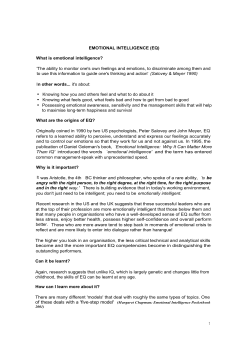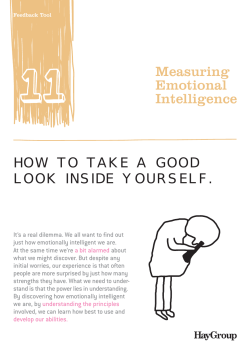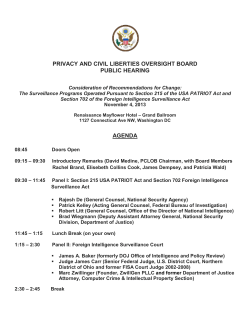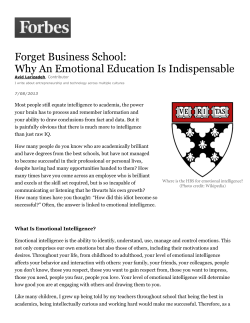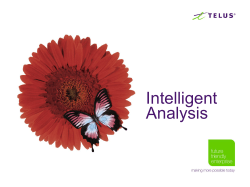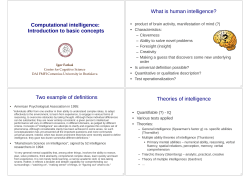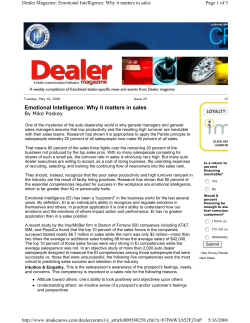
supplemented by efforts on the part of government
Intelligencer Association of Former Intelligence Officers From AFIO's The Journal of U.S. Intelligence Studies Volume 20 • Number 1 • $15 single copy price Spring/Summer 2013 Web: www.afio.com, E-mail: afio@afio.com ©2013, AFIO Guide to the Study of Intelligence Why Teach About Intelligence by Stephen Marrin, Ph.D. I ntelligence studies gain a lot of attention because of the links to spies and spying. The subject influences popular culture through action-packed books, television shows and movies, and consequently people become curious about the real world of intelligence. The success of the International Spy Museum in Washington, DC, demonstrates the overlap between myth and reality. Teaching about intelligence provides an opportunity to bring James Bond and Jack Ryan into the classroom, but the actual substance of intelligence studies can be much, much more than what Hollywood depicts. While the literature about teaching intelligence has been getting more attention recently, its foundations began many decades ago.1 In 1957 Washington Platt recommended that intelligence organizations adapt “formal education followed by practical experience” for those who wanted to enter, and suggested that the best way to do so was through “more advanced courses, comparable to graduate courses in other professions.”2 In 1960, Peter Dorando recommended that academic colleges or universities create “a basic course of study in the meaning of intelligence, its significance as the foundation for policy planning and a guide for operations, how it plays those roles, and the principles and processes by which it is produced and formulated. Such a course should…develop broad principles applicable in all fields.”3 The field of intelligence education took many more years to develop fully. By the 1980s the literature on teaching intelligence consisted of field surveys4 1. For more about teaching intelligence, see chapter titled “Improving Intelligence Analysis Through Training and Education” in Stephen Marrin. Improving Intelligence Analysis: Bridging the Gap between Scholarship and Practice. Routledge 2011. 2. Washington Platt’s “Strategic Intelligence Production: Basic Principles.” Praeger, 1957. 256-258. 3. Peter J. Dorando. “For College Courses in Intelligence.” Studies in Intelligence 4, no. 3 (1960): A15-A19. 4. Marjorie W. Cline (ed). Teaching Intelligence in the mid-1980s: A Spring/Summer 2013 7700 Leesburg Pike, Suite 324 Falls Church, Virginia 22043 supplemented by efforts on the part of government organizations to support the teaching of intelligence.5 But as a wide variety of intelligence education programs sprung up after the 9/11 terrorist attacks to meet the demand for more focused education and training in this area, the literature on teaching intelligence has expanded even further. Contributions now provide an overview of the value of intelligence education, and critique its somewhat haphazard implementation.6 With the creation of the International Association for Intelligence Education (IAFIE) in 2004, more research and writing has been done on various aspects of teaching intelligence, some of which have ended up in the literature.7 All of this work has shown that those who teach intelligence do so for a number of different purposes and from a number of different perspectives. One purpose in teaching intelligence is to explain how the US government is structured and what it does. Most of the students who take courses on intelligence in political science departments around the country acquire this kind of knowledge. This can also lead to discussion of how intelligence organizations are subject to the checks and balances of the political system, and how the executive, legislative, and judicial branches are each involved in the process of governance. As such, it normalizes the intelligence function as part of the machinery of government. When the instructor focuses on the branches of government or case studies on the role of intelligence in supporting Survey of College and University Courses on the Subject of Intelligence. National Intelligence Study Center. Washington DC. 1985; Hayden Peake. The Reader’s Guide to Intelligence Periodicals. National Intelligence Book Center. Washington DC. 1989. 5. US Central Intelligence Agency. Symposium on Teaching Intelligence, October 1-2,1993. Washington, DC: Center for the Study of Intelligence, 1994; US Joint Military Intelligence College. Teaching Intelligence at Colleges and Universities. Conference Proceedings. Washington DC; Center for Strategic Intelligence Research. 18 June 1999; US Joint Military Intelligence College. A Flourishing Craft: Teaching Intelligence Studies. (Ed. Russell G. Swenson). Papers Prepared for the 18 June 1999 JMIC Conference on Teaching Intelligence Studies at Colleges and Universities. Washington DC: Center for Strategic Intelligence Research. June 1999. 6. Martin Rudner. “Intelligence Studies in Higher Education: Capacity-Building to Meet Societal Demand.” International Journal of Intelligence and Counterintelligence 22, no. 1 (Spring 2009): 110-130. Peter Monaghan. Intelligence Studies. The Chronicle of Higher Education. 20 March 2009. William Spracher. “Teaching Intelligence in the United States, the United Kingdom, and Canada.” International Studies Encyclopedia. Ed. Robert A. Denemark. Malden, MA: Wiley-Blackwell, 2010. 6779-6800; Stephen Campbell. “A Survey of the U.S. Market for Intelligence Education.” International Journal of Intelligence and Counterintelligence 24, no. 2 (Summer 2011): 307-337. 7. Mark Lowenthal. “Intelligence as a Profession: IAFIE Sets Its Sights.” American Intelligence Journal, Summer 2006. 41–42. Intelligencer: Journal of U.S. Intelligence Studies Page 67 foreign policy, the goal is to provide the student with a broad foundation of knowledge in order to contextualize the more focused study of intelligence in the making and execution of foreign or national security policy. A variation of this approach to teaching intelligence can be used in comparative politics courses; those that compare different kinds of political systems. For example, during the Cold War there was an effort to understand the different kinds of intelligence services based on the political system of the respective government (democracy, communist, dictatorship) and what that meant in terms of the strengths and weaknesses of the various systems of intelligence.8 More recent efforts take differences between different countries and compare how the systems of intelligence fit within the overall machinery of government.9 Studying and teaching intelligence in this way provides the student with an opportunity to explore the theoretical constructs that predominate in comparative politics using intelligence-related cases and illustrations.10 Variations to this political science approach can also be taken in world politics, area studies, or international relations courses using varied frames of reference, depending on the knowledge and expertise of the instructor. Inevitably, the most accessible cases to use would be those related to security studies or international security. For example, one could teach intelligence in context of particular kinds of national security threats including regional actors (North Korea, Iran), areas of instability (Syria, Egypt), areas of conflict (Afghanistan, Syria), the proliferation of WMD materials, and various non-state actors (terrorism, narco-trafficking, money laundering, piracy). The intelligence studies portion of the course would then examine the role of intelligence in helping governments understand the threat (separating out capabilities and intentions) by addressing what it does in order to collect and evaluate information on these kinds of targets. The security studies portion of the course 8. Roy Godson (ed). Comparing Foreign Intelligence: The U.S., the USSR, the U.K. and the Third World. Washington, DC: Pergamon-Brassey’s, 1988. 9. Philip H.J. Davies. Intelligence and Government in Britain and the United States: A Comparative Perspective. ABC-Clio/Praeger. 2012. Peter Gill, Mark Phythian, Stuart Farson, and Shlomo Shpiro (eds). Handbook of Global Security and Intelligence National Approaches. Westport, CT: Praeger Security International, 2008. 10. Peter Gill. “Knowing the Self, Knowing the Other: The Comparative Analysis of Security Intelligence” in Loch Johnson (ed) Handbook of Intelligence Studies. Routledge. 2007. 82-90.; Kevin O’Connell. “Thinking about Intelligence Comparatively.” The Brown Journal of World Affairs 11, no. 1 (2004): 189–202. Page 68 could address how intelligence helps governments know what the threat is (description), why it developed (explanation), its significance (evaluation), and how it is likely to change in the future (forecasting), and use that as an opportunity to discuss the various kinds of intelligence products. Another purpose for teaching intelligence is to understand American or world history. Taking the historian’s perspective can lead to discussions of the involvement of intelligence organizations in various episodes in American history, from the Revolutionary War up to recent modern history. The historian’s approach can help students understand what happened in the past that led the world to be as it is. Intelligence has played a role in the rise and fall of civilizations, the winning and losing of both battles and wars, and—just as significant—the prevention of conflict as part of a broader conception of national security. Incorporating intelligence into the study of history provides a more detailed and nuanced understanding of the real world of foreign policy and policymaking. Editors’ Note: Understanding History Dr. Mark Stout, the International Spy Museum’s historian and Johns Hopkins University professor, has noted that our understanding of history has changed once intelligence files were declassified or revealed. Some of his examples are illustrative: The Normandy landings and many of the Allied victories in Europe during World War II were the consequence of good intelligence and derivative deceptions of the Nazis (Sicily, Normandy). In the Battle of the Atlantic, Allied victory over German U-boats was dependent largely upon signals intelligence. In the Pacific, the Battle of Midway was the canonical example of the contributions of SIGINT to having foreknowledge of an enemy’s plans and countering them successfully. Cold War controversies, such as the guilt or innocence of the Rosenbergs and Alger Hiss, were really only settled with the release of VENONA decrypts of Soviet GRU and KGB communications indicating both were controlled Soviet agents. Was Senator Joseph McCarthy right in his charges about communists in the US Government? With the release of VENONA and old investigative files we now know that he mostly wasn’t. The nature of the Communist Party of the USA: was it deeply involved in espionage or were simply a few of its members spies for the USSR? We know the Intelligencer: Journal of U.S. Intelligence Studies Spring/Summer 2013 answer to this thanks to the work of scholars like John Earl Haynes and Harvey Klehr working with the VENONA decrypts, the Mitrokhin files, the Vassiliev materials, and other revelations that have dribbled out of KGB archives. The outcome of the pivotal 1948 Italian elections in which the CIA ran its first covert action supporting the democrats; the KGB was even more heavily subsidizing the Italian Communist Party. The Washington Naval Treaty of 1922; the US side was greatly helped by the SIGINT work of Herbert Yardley’s American Black Chamber. Christopher Andrew argues compellingly in The World Was Going Our Way (Basic Books. 2005) that KGB operations were central to — not peripheral to — the conduct of Soviet foreign policy. In addition, Dr. Stout has noted, some major historical events are intrinsically intelligence stories. The following are some major historical incidents which one cannot comprehend fully without assessing their related intelligence issues. The Battle of Gettysburg The Zimmerman Telegram The attack on Pearl Harbor The Cuban Missile Crisis The 1968 Tet Offensive The 1973 coup against Allende in Chile The Soviet war in Afghanistan The US war in Afghanistan The 2003 Iraq War Understanding the nature of the East German state. In variation to the disciplinary approach one can also study intelligence as a subset of other academic fields; anthropology, sociology, communications, media studies, film or literature, and others. Each academic discipline will have its own way of orienting the student to the subject and providing contextualizing approaches for critical thought and evaluation. Some of these approaches will use a similar social scientific lens but shift the emphasis to different kinds of questions. Others will abandon social science altogether and focus on different kinds of theories and modes of understanding. For example, former CIA case officer Fred Hitz’s course at Princeton University on “The Myth and Reality of Espionage: The Spy Novel” provided an opportunity to explore other aspects of the business, including legality and morality.11 11. Ken Howard. “Myth and Reality of Espionage: Former CIA Spring/Summer 2013 An additional purpose for teaching intelligence is to prepare the student for a career in intelligence. This can be done at the course or programmatic level. Sometimes entire programs or degrees are built on this purpose. Those that do so are like other graduate-level public policy schools who prepare students for careers in government by providing them with knowledge about the field as well as some of the skills associated with it. These are ‘intelligence schools’ which serve a similar function for the intelligence profession as do medical schools for medicine or journalism schools for journalism. In this case, however, most of these practitioner-oriented schools tend to emphasize intelligence analysis because it is the analytic skill-set which is most easily developed in the academic context.12 As more programs are created which do this, more resources are becoming available for those who want to teach students what intelligence analysis entails. In addition to the conventional teaching methods of readings, lecture and discussion, sometimes teaching in different ways can help in the learning process. For example, teaching intelligence in historical context can also have a more practical or applied focus; learning the lessons of history. A number of instructors have recommended the case study approach to teaching intelligence, and have written a variety of case studies to help in that process. Others use interactive simulations as well. An approach used in some of these kinds of courses is the practical simulation or exercise related to intelligence analysis and production; the crisis simulation or exercise in producing a National Intelligence Estimate. Some of these simulations take place entirely in an academic context; others include outside actors playing roles of senior decision makers. The CIA has supported some of these exercises, getting involved both in their creation as well as their implementation. The value of this kind of exercise is that it shifts the learning emphasis from the normal ‘reading, thinking, writing’ approach to one of ‘learning by doing.’ The intent is for one kind of learning to reinforce the other; to provide Inspector General Leads Freshman Seminar Based on Life Experience,” Princeton Weekly Bulletin. Vol 89 No 13. January 10, 2000. http://www.princeton.edu/pr/pwb/00/0110/p/espionage.shtml. 12. Stephen Marrin. “Training and Educating US Intelligence Analysts.”International Journal of Intelligence and Counterintelligence. 22.no. 1. (Winter 2008-2009). 131-146; James Breckenridge. “Designing Effective Teaching and Learning Environments for a New Generation of Analysts.” International Journal of Intelligence and Counterintelligence 23, no. 2 (Summer 2010): 307-323; Michael Landon-Murray. “Social Science and Intelligence Analysis: The Role of Intelligence Education,” Journal of Applied Security Research, 6:4 (2011). 491-528. Intelligencer: Journal of U.S. Intelligence Studies Page 69 real world examples of issues or difficulties involved in the production of intelligence. READINGS FOR INSTRUCTORS There are many resources available that can be used to teach intelligence depending on which kind of course is envisaged and the level of student involved. There are a couple of overview books, which have become predominant in terms of teaching introductory intelligence courses: Mark Lowenthal. Intelligence: From Secrets to Policy. CQ Press College; 5th edition. 2011. Christopher Andrew. For the President’s Eyes Only. Harper Perennial. 1996. Much of the intelligence literature is produced in article form, so access to the journals in the field should supplement content from books. The three primary academic journals are (1) the International Journal of Intelligence and Counterintelligence, (2) Intelligence and National Security, and (3) CIA’s Studies in Intelligence.13 The best place to go to find a breakdown of this literature by topic is J. Ransom Clark’s online annotated bibliography of the intelligence literature, found here: http://intellit.muskingum.edu/. There are also books, which have compiled a thematic ‘best of’ from previously published works. These can be good overviews for courses on intelligence and national security: Christopher Andrew, Richard J. Aldrich, and Wesley K. Wark (eds). Secret In t e llig e n c e : A Reader. New York and London: Routledge, 2009. Loch K. Johnson and James J. 13. The Association of Former Intelligence Officers (AFIO), Naval Intelligence Professionals (NIP), and the National Military Intelligence Association (NMIA) publish journals with articles about the intelligence profession. AFIO’s Intelligencer is published in print three times per year. Online-only are the journals by NIP – Naval Intelligence Professionals Quarterly – and NMIA’s American Intelligence Journal which appears online once a year. All of these journals tend to emphasize practitioner-authors rather than academic researchers. Page 70 Wirtz (eds). Intelligence and National Security: The Secret World of Spies. New York/Oxford. Oxford University Press. 2nd edition. 2008. Roger Z. George and Robert D. Kline (eds). Intelligence and the National Security Strategist: Enduring Issues and Challenges. Rowman and Littlefield Publishers. 2006. Another option would be books that have acquired a range of articles on different subject matter—not previously published—which could be used to supplement other books or articles: James Bruce and Roger George (eds). Analyzing Intelligence: Origins, Obstacles, and Innovations. Georgetown University Press. 2008. Loch Johnson (ed). Handbook of Intelligence Studies. Routledge. 2006. 199-210. Peter Gill, Stephen Marrin and Mark Phythian (eds). Intelligence Theory: Key Questions and Debates. Routledge. 2008. Resources to support the use of case studies in teaching intelligence include: Timothy Walton. Challenges in Intelligence Analysis: Lessons from 1300 BCE to the Present. New York: Cambridge University Press, 2010. Thomas W. Shreeve. Experiences to Go: Teaching with Intelligence Case Studies. Wa shing t o n D C: Joint Military Intelligence College. September 2004. Ernest R. May and Philip D. Zelikow (eds)., Dealing with Dictators: Dilemmas of U.S. Diplomacy and Intelligence Analysis, 1945–1990. BCSIA Studies in International Security. Cambridge, MA: The MIT Press. 2006. Intelligencer: Journal of U.S. Intelligence Studies Spring/Summer 2013 Resources to support intelligence school analytic skills and simulations include: US Central Intelligence Agency. A Tradecraft Primer: Structured Analytic Techniques for Improving Intelligence Analysis. US Government. March 2009. Available online at https:// www.cia.gov/library/center-for-the-study-of-intelligence/ csi-publications/books-and-monographs/Tradecraft%20 Primer-apr09.pdf Richards J. Heuer, Jr., and Randolph H. Pherson. Structured Analytic Techniques for Intelligence Analysis. Washington, DC: CQ, 2010. James Major. Communicating with Intelligence: Writing and Briefing in the Intelligence and National Security Communities. Lanham, MD: Scarecrow, 2008. Kristan J. Wheaton. “Teaching Strategic Intelligence Through Games.” International Journal of Intelligence and Counterintelligence 24, no. 2 (Summer 2011): 367-382. CO NTAC T U S 8 0 0 F St r e et , N W Wa s h i n g t o n , DC 2 0 0 0 4 P : 2 02 . E Y E . S PY U E : i n f o @s pym u s e u m . o r g w w w. s pym u s e u m . o r g MUSEUM HOURS O p e n E ve r y D ay 9 AM - 7 PM Dr. Stephen Marrin is associate professor teaching Intelligence Analysis (IA) in the Department of Integrated Science and Technology (ISAT) at James Madison University in Harrisonburg, Virginia. Before that he taught intelligence in the Department of Politics and History at Brunel University, London, England. Before that he taught in the Intelligence Studies Department at Mercyhurst University in Erie, PA. Previously, he was an analyst with the Central Intelligence Agency, and later with the U.S. Government Accountability Office (GAO). Holder of a Ph.D. from the University of Virginia, he is Program Chair of the Intelligence Studies Section of the International Studies Association and was previously on the Board of the International Association for Intelligence Education. A prolific author on aspects of intelligence analysis and analytical theory, the National Journal in 2004 profiled him as one of the ten leading experts on the subject of intelligence reform. Spring/Summer 2013 Intelligencer: Journal of U.S. Intelligence Studies Page 71
© Copyright 2025
